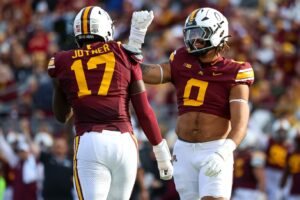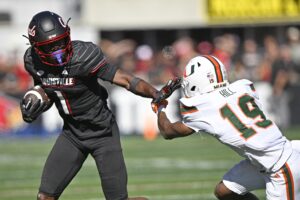The third installment of history of Pittsburgh Steelers jersey numbers looks at the players who wore jersey numbers 20 through 29. Some were Hall of Fame players, some were stars, while others were just popular role players who developed a following. What each player had in common was that they all proudly wore Pittsburgh Steelers jersey numbers.
History of Pittsburgh Steelers Jersey Numbers: Volume Three
Number 20 – Rocky Bleier
The History of Pittsburgh Steelers Jersey Numbers: Volume Three begins with Rocky Bleier. Bleier was the Steelers 16th round draft pick in 1968, out of Notre Dame. That December Bleier was drafted again, by the U.S. Army, to fight in Vietnam. On August 20th, 1969, while on patrol with his platoon in Heip Duc, he was shot in the left thigh. Moments later an enemy grenade landed near him and exploded. Shrapnel exploded into his lower right leg, causing him to lose part of his right foot as well. While recovering in a Tokyo hospital, doctors told him his football career was over.
Soon after, Rocky received a post card from Art Rooney that read “Rock, the team’s not doing well. We need you,” signed Art Rooney. After two painful years of rehabbing, and being waived twice, Rocky rejoined the Steelers in 1971. Three years later, in 1974, Bleier became a starter. In 1976, Rocky joined Franco Harris in the 1,000 yard club. They became just the second pair of running backs to do that since 1972. Bleier won four Super Bowl rings during his career with the Steelers, and retired following the 1980 season. At the time of his retirement, Bleier was the Steelers fourth all-time leading rusher with 3,865 yards.
Number 21 – Tony Dungy:
Tony Dungy is best known as the Super Bowl winning head coach of the Indianapolis Colts. His NFL start, however, came as safety for the Pittsburgh Steelers from 1977-1978. During his two years, he was a contributing member of the Super Bowl XIII champions. Dungy left the Steelers following the 1978 season. He played one year for the San Francisco 49ers before retiring as part of the 1980 New York Giants practice squad.
Dungy was recognized as an intelligent player, and thus hired by Chuck Noll to coach his secondary in 1981. Dungy’s performance earned him a promotion in 1984, when Noll named him defensive coordinator. He was the first African-American in NFL history to be named as a defensive coordinator. Dungy ran an aggressive attack style defense that helped lead the Steelers to the ’84 AFC Championship game. He would serve as the Steelers defensive coordinator until 1988.
Number 22 – Bobby Layne:
Bobby Layne was originally drafted by the Steelers with the third overall pick in the 1948 NFL draft. Layne refused to play with the Steelers because they still ran the single wing formation. The Steelers quickly traded his rights to the Chicago Bears. In 1957, head coach Buddy Parker arranged a trade with the Detroit Lions to bring Layne to Pittsburgh. Layne played five seasons with the Steelers, two of which he made the pro-bowl. While he never lead the Steelers to the playoffs, Layne brought them to respectability.
Layne had a record of 27-22-2 with the Steelers, completing 569 of 1,156 passes for 9,030 yards. He tossed 66 touchdowns and 81 interceptions. Layne was also credited with creating the two-minute drill. In 1962, Layne’s last with the Steelers, and in the NFL, he published his biography “Always on Sunday”. Layne later went on to say that his biggest regret was that he never won a championship for the Steelers, and specifically, owner Art Rooney.
Number 23 – Mike Wagner:
Mike Wagner was the Steelers 11th round draft pick in 1971, and played safety from 1971 through 1980. He was the signal caller for a legendary Steel Curtain defense that led Pittsburgh to four Super Bowl titles. Wagner was intelligent, physical, and picked off 36 passes playing alongside Mel Blount and Donnie Shell. He was a two time Pro-Bowl selection in 1975 and1976. Wagner tied for the NFL lead in interceptions in 1973. In 2015, Wagner was inducted into the Pittsburgh Pro Football Hall of Fame with Dermonti Dawson, Andy Russell, Ernie Mills, and announcer Bill Hillgrove.
Number 24 – Ike Taylor:
Drafted by the Steelers in 2003, Ike Taylor was an extremely raw but athletic prospect. Bill Cowher believed Taylor could have an impact in the secondary. Taylor was a converted running back who played one season at cornerback in college. Used mostly on special teams, with some spot duty on defense, Taylor cracked the starting lineup in 2005. He played a big role in helping the Steelers win their fifth Lombardi Trophy in super Bowl XL. In 2006, Taylor’s play regressed to the point that he was benched in favor of DeShea Townsend.
Taylor regained his starting spot in 2007, under new head coach Mike Tomlin. Taylor holds the franchise record for consecutive post-season games (four) with an interception. The biggest knock on him was his ability to catch a football. Taylor played his entire career with the Pittsburgh Steelers. From 2007 through 2011, Taylor was one of the best shutdown corners in the league. During his 12 year career, Taylor totaled 517 tackles, three sacks, 14 interceptions and recovered five fumbles.
Pittsburgh Steelers Jersey Numbers 25 – 29
Number 25 – Ron Shanklin:
Ron Shanklin was drafted out of North Texas in the second round of the 1970 NFL draft. Shanklin spent five years with the Steelers, coinciding with the growing pains that plagued Terry Bradshaw‘s first five years. Because of Bradshaw’s struggles, the Steelers never got to see the full abilities that Shanklin possessed. Shanklin averaged 18.4 yards per catch, with a career long reception of 81 yards. During his five years with the Steelers, Shanklin caught 166 passes for 3,047 yards and 24 touchdowns.
Number 26 – Rod Woodson:
When the Steelers selected Rod Woodson in the 1987 NFL Draft, they knew they were getting a special player. Nobody could have predicted he would become the best all around cornerback in NFL history. At six feet and 205 pounds, Woodson was a physical presence on the field. He was equally adept at stuffing the run as he was in coverage. Woodson played with the Steelers from 1987 through 1996. He went to the Pro-Bowl seven times and was a five time all-pro. In 1995, Woodson became the first player to return during the same season that he had reconstructive knee surgery.
During the first game of 1995, Woodson tore his ACL attempting to tackle Detroit Lions running back Barry Sanders. Coach Cohwer’s refusal to put Woodson on season ending IR gave him the chance to play in Super Bowl XXX. During the game, Woodson broke up a pass intended for Michael Irvin. He hopped up and pointed at his surgically repaired knee, implying it was good to go. During his ten years with the Steelers, Woodson intercepted 38 passes, returning five for touchdowns. Woodson was the ultimate shutdown corner and a major piece of the best defense in Pittsburgh since the 70’s.
Number 27 – Glen Edwards:
Glen Edwards was a big hitting safety who played for the Steelers from 1971 through 1977. Drafted out of Florida A&M, Edwards was very productive while in Pittsburgh. During his seven seasons, Edwards was a two time Pro-Bowler, 1974-1975. He was an AP first team All-Pro in 1976, and won two Super Bowl rings. In Super Bowl IX, Edwards assisted on Mel Blount’s interception by belting receiver John Gilliam just as the ball arrived.
Edwards’ end zone interception of Roger Staubach in Super Bowl X preserved the Steelers second consectutive championship. Following the 1977 season, Edwards was traded to the San Diego Chargers. He had 25 interceptions during his Steelers career, returing two of them for touchdowns. He also recovered eight fumbles and forced seven more.
Number 28 – Lupe Sanchez:
Guadalupe Ledezma “Lupe” Sanchez came to the Steelers as a free agent in 1986, and played through 1988. The first action he saw with the Steelers was as a kick returner. Over his three year NFL career, Lupe returned 35 kickoffs for 778 yards, including a long of 64. As a safety, Sanchez played in 39 games, starting in nine of them. He recorded four interceptions, including one for a touchdown.
Number 29 – Barry Foster
The History of Pittsburgh Steelers Jersey Numbers: Volume Three ends with Barry Foster. Foster came to the Steelers in the 1990 NFL Draft. He exploded on the scene in 1992, after rushing for 1,690 yards and 11 touchdowns. While Foster wasn’t exactly a one year wonder, he only rushed for 1,562 yards during his final two years with the Steelers. His career ended due to an ankle injury.
During his five year career with Pittsburgh, Foster gained 3,943 yards on 915 carries, and scored 26 touchdowns. Foster was built like a bowling ball, possessing a nice combination of speed and power. He chose to retire following his departure from Pittsburgh.
This finishes up the history of Pittsburgh Steelers jersey numbers: Volume Three. Although it’s a bit lengthy, it was a very interesting process to put together. The next installment will cover some of the players who wore jersey numbers 30 through 39, including Jerome Bettis. Go to steelers.com for the complete list of players who wore Pittsburgh Steelers jersey numbers 20 through 29.
Main Image:






